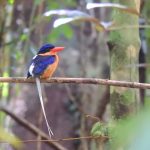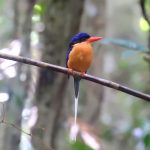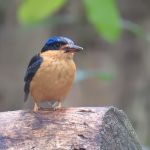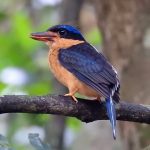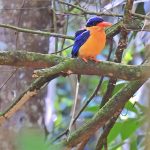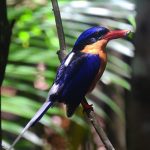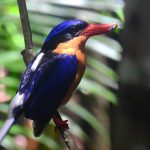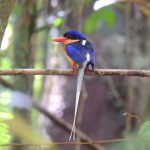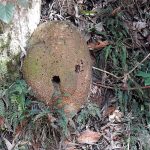BUFF-BREASTED PARADISE KINGFISHER
Imagine you’re wandering along the edge of an Australian rainforest, morning light filtering through the thick green canopy. You spot a sudden glimmer of blue—a tiny, radiant bird darting by, with two long, ribbon-like white tail feathers trailing behind. You’ve just glimpsed the Buff-breasted paradise kingfisher, one of the forest’s most eye-catching residents.
What really makes these kingfishers so special, apart from their colourful feathers, is how they raise their families. Each year, as the wet season rolls in, these birds travel a long way from Papua New Guinea to northern Australia. They know exactly where to go—seeking out rainforest edges and monsoon forests that have just the right conditions for raising their young.
When it’s time to start a family, the Buff-breasted paradise kingfisher does something quite extraordinary: instead of building a nest in the branches, the pair finds a termite mound nearby. Using their strong, chisel-like bills, they chip away at the tough outer wall, working together to hollow out a deep tunnel. It can take several days, and if you watch closely, you might see a pair taking turns—one digging while the other waits, then swapping over. The inside of the mound stays cool, safe from predators and the wild tropical weather—a perfect nursery for their eggs and chicks.
Once they’ve finished their earthy tunnel, the female usually lays around three to five small white eggs deep inside. There’s no soft lining—just the bare earth of the mound. Both parents share the job of keeping the eggs warm and, once the chicks hatch, they’re both busy bringing food. Imagine the commotion inside: tiny chicks eagerly waiting in the dark for mum or dad to swoop in with a tasty beetle or grasshopper.
After about three weeks, the chicks grow strong enough to leave the mound. Until then, the hollow hums with life, a hidden world inside the termite fortress.
Outside, you might spot an adult bird perched motionless on a branch, scanning for movement. When they see something tasty, they swoop down in a quick burst to snatch up insects or small reptiles, then zip back to deliver the meal to the mound.
Though these birds are not currently at risk, their unique way of life depends hugely on healthy forests and the presence of those old termite mounds. It’s a great reminder that preserving wild places protects a whole web of life—from the termites who build the mounds, right up to the dazzling kingfishers who turn them into nurseries.
So, next time you’re near a northern Australian rainforest during the wet season, think of the Buff-breasted paradise kingfisher, quietly digging, nesting, and raising tiny chicks deep inside nature’s very own apartment blocks. Their story is a wonderful example of nature’s creativity and resilience.

